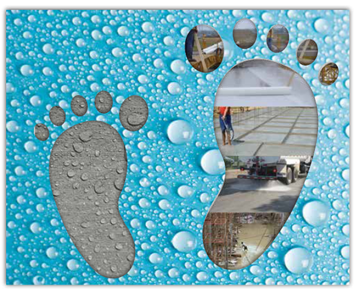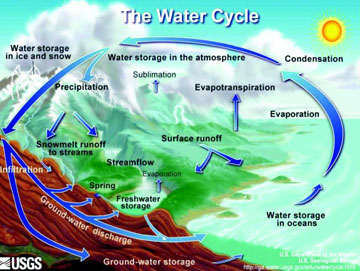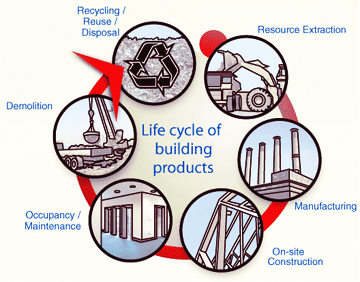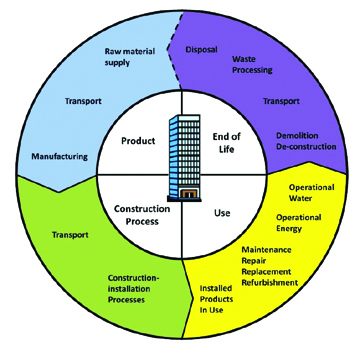Water Foot Print Analysis
 |
Human activities consume and pollute a lot of water. At a global scale, most of the water use occurs in agricultural production, but there are also substantial water volumes consumed and polluted in the industrial and domestic sectors. Water consumption and pollution can be associated with specific activities, such as irrigation, bathing, washing, cleaning, cooling and processing. Total water consumption and pollution are generally regarded as the sum of a multitude of independent water demanding and polluting activities. There has been little attention paid to the fact that, in the end, total water consumption and pollution relate to what and how many communities consume and to the structure of the global economy that supplies the various consumer goods and services. Until the recent past, there have been few thoughts in the science and practice of water management about water consumption and pollution along whole production and supply chains. As a result, there is little awareness regarding the fact that the organization and characteristics of a production and supply chain strongly influence the volumes (and temporal and spatial distribution) of water consumption and pollution that can be associated with a final consumer product. The improved understanding can form a basis for a better management of the globe's freshwater resources.
Water Footprint Concept
 |
The idea of considering water use along supply chains has gained interest after the introduction of the 'water footprint' concept by Hoekstra in 2002 (Hoekstra, 2003). The water footprint is an indicator of freshwater use that looks not only at direct water use of a consumer or producer, but also at the indirect water use. The water footprint can be regarded as a comprehensive indicator of freshwater resources appropriation, next to the traditional and restricted measure of water withdrawal. The water footprint of a product is the volume of freshwater used to produce the product, measured over the full supply chain. It is a multidimensional indicator, showing water consumption volumes by source and polluted volumes by type of pollution; all components of a total water footprint are specified geographically and temporally. The blue water footprint refers to consumption of blue water resources (surface and groundwater) along the supply chain of a product. 'Consumption' refers to loss of water from the available ground-surface water body in a catchment area. Losses occur when water evaporates, returns to another catchment area or the sea or is incorporated into a product. The green
Water footprint refers to consumption of green water resources (rainwater insofar as it does not become run-off). The grey water footprint refers to pollution and is defined as the volume of freshwater that is required to assimilate the load of pollutants given natural background concentrations and existing ambient water quality standards.
The water footprint thus offers a better and wider perspective on how a consumer or producer relates to the use of freshwater systems. It is a volumetric measure of water consumption and pollution. It is not a measure of the severity of the local environmental impact of water consumption and pollution. The local environmental impact of a certain amount of water consumption and pollution depends on the vulnerability of the local water system and the number of water consumers and polluters that make use of the same system. Water footprint accounts give spatiotemporally explicit information regarding how water is appropriated for various human purposes. They can feed the discussion about sustainable and equitable water use and allocation and also form a good basis for a local assessment of environmental, social and economic impacts.
Water footprint assessment
'Water footprint assessment' refers to the full range of activities to:
- Quantify and locate the water footprint of a process, product, producer or consumer or to quantify in space and time the water footprint in a specified geographic area;
- Assess the environmental, social and economic sustainability of this water footprint;
- Formulate a response strategy. Broadly speaking, the goal of assessing water footprints is to analyse how human activities or specific products relate to issues of water scarcity and pollution, and to see how activities and products can become more sustainable from a water perspective.
How a water footprint assessment will look, largely depends on the focus of interest. One can be interested in the water footprint of one specific process step in a whole production chain, or in the water footprint of a final product. Alternatively, one can be interested in the water footprint of a consumer or group of consumers or in the water footprint of a producer or whole economic sector. Finally, one can take a geographic perspective, looking at the total water footprint within a delineated area such as a municipality, province, nation, catchment or river basin. Such a total water footprint is the aggregation of the water footprints of many separate processes taking place in the area.
 |
Water footprint assessment is an analytical tool, it can be instrumental in helping to understand how activities and products relate to water scarcity and pollution and related impacts and what can be done to make sure activities and products do not contribute to unsustainable use of freshwater. As a tool, a water footprint assessment provides insight; it does not tell people 'what to do'. Rather it helps people to understand what can be done.
A full water footprint assessment consists of four distinct phases :
- Setting goals and scope.
- Water footprint accounting.
- Water footprint sustainability assessment.
- Water footprint response formulation.
Water footprint studies may have various purposes and be applied in different contexts. Each purpose requires its own scope of analysis and will allow for different choices when making assumptions. One can assess the water footprint of different entities, so it is most important to start specifying in which water footprint one is interested. One can be interested, for instance, in the:
• Water footprint of a process step
• Water footprint of a product
• Water footprint of a consumer
• Water footprint of a group of consumers
– Water footprint of consumers in a nation
– Water footprint of consumers in a municipality, province or other administrative unit
– Water footprint of consumers in a catchment area or river basin
• Water footprint within a geographically delineated area
– Water footprint within a nation
– Water footprint within a municipality, province or other administrative unit
– Water footprint within a catchment area or river basin
• Water footprint of a business
• Water footprint of a business sector
• Water footprint of humanity as a whole
Types of Water Footprints
- The water footprint of a product = the sum of the water footprints of the process steps taken to produce the product (considering the whole production and supply chain).
- The water footprint of a consumer = the sum of the water footprints of all products consumed by the consumer.
- The water footprint of a community = the sum of the water footprints of its members.
- The water footprint of national consumption = the sum of the water footprints of its inhabitants.
- The water footprint of a business = the sum of the water footprints of the final products that the business produces.
- The water footprint within a geographically delineated area (for example, a municipality, province, state, nation, catchment or river basin) = the sum of the process water footprints of all processes taking place in the area.
What is Water Footprint of a Product
The water footprint of a product is defined as the total volume of fresh water that is used directly or indirectly to produce the product. It is estimated by considering water consumption and pollution in all steps of the production chain. The accounting procedure is similar to all sorts of products, be it products derived from the agricultural, industrial or service sector. The water footprint of a product breaks down into a green, blue and grey component.
 |
A water footprint is expressed in terms of a water volume per unit of product or as a water volume per unit of time (Box 3.2). The water footprint of a process is expressed as water volume per unit of time. When divided over the quantity of product that results from the process, it can also be expressed as water volume per product unit. A product water footprint is always expressed in terms of water volume per unit of product (usually m3/ton or litre/kg). The water footprint of a consumer or producer or the water footprint within an area is always expressed as water volume per unit of time. Depending on the level of detail that one aims to provide, the water footprint can be expressed per day, month or year.
• The water footprint of a process is expressed as water volume per unit of time. When divided over the quantity of product that results from the process (product units per unit of time), it can also be expressed as water volume per product unit.
• The water footprint of a product is always expressed as water volume per product unit. Examples:
– Water volume per unit of mass (for products where weight is a good indicator of quantity)
– Water volume per unit of money (for products where value tells more than weight)
– Water volume per piece (for products that are counted per piece rather than weight)
– Water volume per unit of energy (per kcal for food products, or per joule for electricity or fuels)
• The water footprint of a consumer or business is expressed as water volume per unit of time. It can be expressed as water volume per monetary unit when the water footprint per unit of time is divided by income (for consumers) or turnover (for businesses).
The water footprint of a community of consumers can be expressed in terms of water volume per unit of time per capita.
• The water footprint within a geographically delineated area is expressed as water volume per unit of time. It can be expressed in terms of water volume per monetary unit when divided over the income in the area.
In the case of agricultural products, the water footprint is generally expressed in terms of m3/ton or litres /kg. In many cases, when agricultural products are countable, the water footprint can also be expressed as a water volume per piece. In the case of industrial products, the water footprint can be expressed in terms of m3/US$ or water volume per piece. Other ways to express a product water footprint are for example water volume/kcal (for food products in the context of diets) or water volume/joule (for electricity or fuels).
Linking to material flow analysis, input-output modelling and life cycle assessment
Material flow analysis (MFA) is a method of analyzing the flows of materials in a well-defined system. On a national or regional scale, MFA can be used to study the material exchanges within an economy and between an economy and the natural environment. In industries, MFA can be used to analyse the material flows within a company or along an industrial supply chain involving a number of companies. When applied to a specific product, MFA refers to the study of inputs (resources) and outputs (emissions) along the different steps in the production system of a product. The latter sort of material flow analysis is similar to what is called the 'inventory phase' of life cycle assessment (LCA). LCA is the
investigation and evaluation of the environmental impacts of a given product or service and consists of four phases: goal and scope, life cycle inventory, life cycle impact assessment and interpretation (Rebitzer et al, 2004).
Frameworks such as MFA, LCA and input-output modelling consider the use of various types of environmental resources and look at the various types of impacts on the environment. In contrast, ecological footprint, water footprint, carbon footprint and embodied energy analyses take the perspective of one particular resource or impact. Although it seems logical that 'footprints' are precisely the indicators typically used in MFA, LCA and input-output studies, the methods applied in footprint studies and the methods applied in MFA, LCA and input-output studies do not form one coherent framework of methods. Hitherto, from a water perspective, MFA, LCA and input-output studies do not include freshwater in a sufficient way.
In the input-output research community, there is an increasing interest to include water (see, for example, Dietzenbacher and Velazquez, 2007; Zhao etal, 2009; Wang and Wang, 2009; Yu et al, 2010). Water footprint studies can provide data on the operational water footprint per economic sector, which are necessary input data in environmentally extended input-output studies that aim to include freshwater use.
Also within the LCA community there is an increasing interest in water (Koehler, 2008; Milà i Canals et al, 2009). LCA studies aim to assess the overall environmental impact of products. The use of freshwater has, until recently, received insufficient attention in LCA studies. There are two separate issues. First, freshwater resources in the world are limited, so measuring freshwater appropriation by looking at water consumption and pollution in terms of volumes should therefore be a key element in an LCA study. The green, blue and grey water footprints of a product are good indicators for this total freshwater appropriation. Second, one can look at the local environmental impacts related to the freshwater appropriation. For this latter purpose, water footprint accounting and sustainability assessment can serve LCA studies as summarized in Table 7.2. A product water footprint account contributes to the life cycle inventory for the product; the water footprint sustainability assessment contributes to the life cycle impact assessment.
Some LCA authors have suggested using the term 'water footprint' for what in this manual is called the 'blue water footprint impact index' (Section 4.4.2). In this way, the term 'water footprint' would no longer be a volumetric measure of freshwater appropriation, but a local environmental impact index (Pfister etal, 2009; Ridoutt et al, 2009; Ridoutt and Pfister, 2010; Berger and Finkbeiner, 2010). It has also been proposed to neglect green water footprints, because impacts would be nil (Pfister and Hellweg, 2009). Redefining the water footprint does not make sense, however, from a water resources management perspective, which requires spatially and temporally explicit information on water footprints in real volumes and impacts in real terms as well. Water footprint studies serve two discourses in water resources management. First, data on water footprints of products, consumers, and producers inform the discourse about sustainable, equitable and efficient freshwater use and allocation. Freshwater is scarce, its annual availability is limited. It is relevant to know who receives which portion and how water is allocated over various purposes. For example, rainwater used for bio-energy cannot be utilized for food. Second, water footprint accounts help to estimate environmental, social and economic impacts at catchment level. Environmental impact assessment should include a comparison of each water footprint component to available water at relevant locations and time (accounting for environmental water requirements). The proposal to use the term water footprint for what is called here the 'blue water footprint impact index' is highly confusing. It has been proposed that the water footprint should include environmental impact because the carbon footprint would also do that, namely by weighing different greenhouse gases and expressing them in terms of CO2 equivalents. The fact that greenhouse gases are measured in terms of CO2 equivalents, however, does not mean that the carbon footprint reflects environmental impacts of greenhouse gases. The carbon footprint is a measure of how much greenhouse gases are emitted into the environment caused by human activities. It does not show anything one can reasonably call 'impact'. It just measures emissions, brought into one common denominator. The carbon footprint does not describe the environmental impact of greenhouse gases, such as increased temperatures and changed patterns of evaporation and precipitation. In this sense, the water footprint, carbon footprint and ecological footprint are similar concepts. The carbon footprint measures total emission of greenhouse gases; the ecological footprint measures the total use of bio-productive space; the water footprint measures the total appropriation of freshwater. The total use of space or water does not reflect impacts, in the same way as the total emission of greenhouse gases does not reflect impacts. Footprints show the pressure of humans on the environment, not the impacts.
Reference: The Water Footprint Assessment Manual- by Arjen Y. Hoekstra, Ashok K. Chapagain, Maite M. Aldaya and Mesfin M. Mekonnen